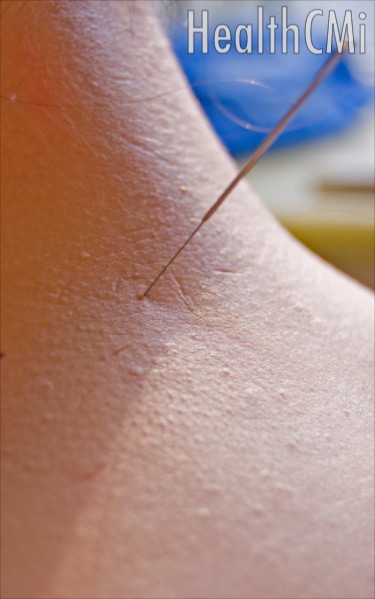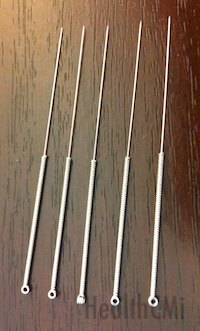New research concludes that acupuncture is effective for the treatment of neck injuries.  Investigators find acupuncture effective in the restoration of cervical range of motion in cases of damage to the intervertebral discs. Additionally, X-ray findings confirm that acupuncture benefits the cervical spine. Acupuncture significantly restores normal curvature to the neck after injury.
Investigators find acupuncture effective in the restoration of cervical range of motion in cases of damage to the intervertebral discs. Additionally, X-ray findings confirm that acupuncture benefits the cervical spine. Acupuncture significantly restores normal curvature to the neck after injury.
In a controlled rabbit model laboratory experiment, acupuncture restores cervical range of motion that has been impinged by spondylosis, a painful condition of the spine due to disc degeneration. Spondylosis related spinal curvature issues were found to respond with positive results with acupuncture. The study demonstrated that acupuncture effectively restores normal cervical curvature in cases of spondylosis. In addition, some cases demonstrated successful widening of the intervertebral foramen as a result of acupuncture treatments.
A related study of 78 humans concluded that a combination of acupuncture, massage and Chinese herbal medicine “has a significant curative effect on cervical spondylosis, and deserves clinical promotion and application.” This type of combination therapy is common in Traditional Chinese Medicine (TCM) hospitals and clinics. TCM consists of several major clinical application components including acupuncture, herbal medicine, Qi Gong, Tui-Na massage and dietetics.
A recent related study published in China Medicine and Pharmacy posted similar findings. Researchers concluded that acupuncture combined with herbs is effective for the treatment of spondylotic related radiculopathy. Group 1 was tested with acupuncture combined with the herbal decoction Huang Qi jia Gui Zhi Fu Ling Wan. Group 2 received only acupuncture. Both groups improved with clinical reductions of numbness and pain. The acupuncture only group had 15 cured, 18 markedly effective and 11 improved patients. The acupuncture plus herbal medicine group had 22 cured, 20 markedly effective and 7 improved patients.
This acupuncture continuing education research has emerged while another recent study finds that acupuncture is more effective than the drug Meloxicam for the treatment of neck disc herniations. In an investigation of 420 patients, acupuncture demonstrated superior clinical results over the NSAID (nonsteroidal anti-inflammatory drug). Acupuncture was significantly more effective in the long-term and short-term reduction of pathological signs and symptoms caused by neck disc herniations. Acupuncture was more successful in the restoration of cervical motion including lateral flexion, back bending and side turning. Acupuncture was also significantly more effective in the reduction of pain, numbness and tenderness. Objective testing confirmed that acupuncture exerted superior clinical benefits over the Meloxicam. Tendon reflexes, brachial plexus traction tests and spurling tests showed greater long and short-term improvements with acupuncture. 
Patients received acupuncture at GV14 and UB11. The points were connected with electroacupuncture leads and stimulated with a 40 Hz pulse with an intensity of 2 mA for a period of 20 minutes. Acupuncture was administered one time per day for a total of 10 acupuncture treatments per course. A day off from care was taken following the first course that was followed by the identical procedure for one more course.
References:
World Chinese Medicine, 2014, Guo Changqing, Liu Fushui, Zhong Dingwen, Zhang Yi, 100029, 3300029,doi:10.3969/j.issn.1673-7202.2013.12.033
Chinese Manipulation & Rehabilitation Medicine, 2013. R279,9; 511300.
Observation on the therapeutic effect of acupuncture combined with Astragalus and cinnamon twig five ingredients decoction for cervical spondylotic radiculopathy. China Medicine and Pharmacy, XUE Aiguo, RUAN Bingyan, LI Hong'er; 523300, 2103 (22), R274.9.
Wu, Yao-chi, Jun-feng Zhang, Yi-jun Sun, Cheng-fei Huang, Ping Shao, and Gui-zhen Liu. "Clinical study on electroacupuncture for cervical intervertebral disc herniation." Journal of Acupuncture and Tuina Science 11, no. 6 (2013): 371-374.


